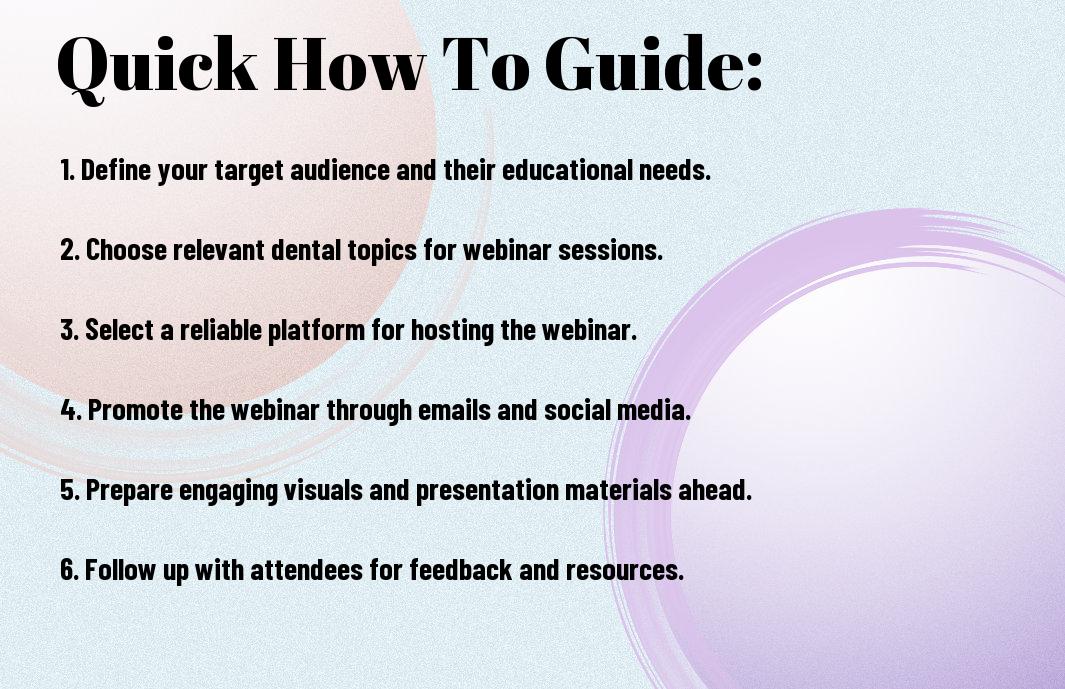How To Host Educational Webinars In Dentistry To Engage And Inform Patients
Webinars offer a fantastic opportunity to connect with your patients while providing them with valuable information about their dental health. As I guide you through the necessarys of hosting engaging and informative webinars, I’ll share tips on how to choose relevant topics, utilize effective technology, and ensure an interactive experience. By following these strategies, you can build trust and foster a strong relationship with your patients, ultimately enhancing their commitment to maintaining their oral health.

Key Takeaways:
- Target Audience: Identify and understand your audience’s interests and concerns to tailor your content effectively.
- Engaging Content: Use a mix of visual aids, storytelling, and interactive elements to maintain interest and encourage participation.
- Expert Speakers: Collaborate with dental professionals to present credible information and increase audience trust.
- Platform Selection: Choose a user-friendly and reliable webinar platform to enhance accessibility and technical reliability.
- Promotion Strategies: Utilize social media, email newsletters, and your practice’s website to promote the event and boost attendance.
- Follow-Up Engagement: Send post-webinar materials and surveys to gather feedback and maintain ongoing communication with attendees.
- Continuous Improvement: Analyze feedback and attendee engagement to refine and improve future webinars for better outcomes.

Understanding Your Audience
Your success in hosting engaging and informative educational webinars in dentistry heavily relies on understanding your audience. By getting a clear grasp of who your patients are and what they need, you can create a meaningful experience that resonates with them. Knowing the demographic range of your audience—such as age, income level, oral health literacy, and specific dental concerns—allows you to customize your content effectively. This groundwork will lead to better engagement and facilitate open discussions during your webinars.
Identifying Patient Needs
Clearly, identifying the needs of your patients is a foundational step in planning your webinars. I encourage you to conduct surveys or informal interviews to gather insights on what questions your patients have about oral health, procedures, or services you offer. Understanding their pain points, interests, and preferences will guide your content creation. For example, if you discover that many patients are anxious about dental procedures, you can address this concern directly in your presentations, offering tips and strategies to ease their fears.
Tailoring Content to Patient Demographics
You must consider the demographic factors of your audience to create targeted and appealing content. For instance, younger patients may appreciate digital tools and quick tips, while older patients might be more interested in in-depth explanations and understanding the implications of complex procedures. Additionally, I’ve found that using appropriate language and examples relevant to each age group fosters a sense of connection and trust.
A successful approach to tailoring content for patient demographics means focusing on the specific interests and concerns of each group. If I am presenting to a family-oriented audience, I might incorporate child-friendly dental tips and family-oriented care options. Alternatively, for older adults, I would emphasize the importance of preventive care and addressing chronic conditions. By aligning your content with the unique needs of your audience, you establish your authority while ensuring your patients feel seen and valued, ultimately leading to a more engaging and informative webinar experience.

Planning Your Webinar
You need to approach the planning phase of your webinar with careful consideration to ensure that it effectively engages and informs your patients. Begin by identifying the purpose of your webinar and the audience you wish to reach. Consider the unique needs and concerns of your patients, as well as current trends in dentistry that could provide valuable information. A well-planned webinar not only serves educational purposes but also strengthens the relationship between your practice and your patients.
Choosing the Right Topic
You should focus on selecting a topic that resonates with your audience. Think about common questions or misconceptions your patients may have regarding dental health, treatment options, or preventive care. Possible topics could include oral hygiene techniques, the importance of regular check-ups, or the latest advancements in cosmetic dentistry. The key is to provide content that is insightful and relevant, giving your patients a deeper understanding of their dental health.
Setting Objectives and Goals
Setting clear objectives and goals for your webinar is important for measuring its success. You’ll want to define what you wish to achieve by the end of the session, such as increasing patient awareness of a specific procedure or improving their understanding of dental hygiene. By outlining your goals, I can ensure that the content is focused and beneficial for your attendees, ultimately leading to better patient outcomes.
Your goals should be specific, measurable, achievable, relevant, and time-bound. For instance, you might aim to have at least 50 attendees and gather feedback that indicates 80% of participants found the information helpful. Establishing these parameters will provide you with a framework to guide your presentation and evaluate the effectiveness of your webinar afterward. You are setting the stage not only for informative content but also for fostering ongoing engagement with your patients.
Selecting the Right Technology
Unlike traditional in-person seminars, hosting educational webinars in dentistry requires a solid understanding of the technology that can facilitate your presentation. My experience shows that choosing the right platform can significantly enhance patient engagement and deliver impactful information. I encourage you to explore resources like How To Host Or Moderate A Webinar for insights on effective technologies tailored for dental webinars.
Webinar Platforms Comparison
With various platforms available, I’ve found it beneficial to compare their features to determine which suits your needs best. Below is a table summarizing the key aspects of popular webinar platforms:
| Platform | Key Features |
| Zoom | User-friendly interface, breakout rooms, screen sharing, and recording capabilities. |
| Webex | Enhanced security features, integrations with other Cisco tools, and high-quality video. |
| GoToWebinar | Robust analytics, automated emails, and in-depth reporting tools. |
| Microsoft Teams | Seamless integration with Office 365, collaboration tools, and easy scheduling. |
Essential Tools for Engagement
Right from the start, I have discovered that engaging your audience is vital during your webinars. Utilizing tools like polls, Q&A sessions, and chat features can keep your patients actively involved and connected with the content. These functionalities allow you to gauge understanding and provide immediate feedback.
Selecting the right tools for engagement not only makes your presentation more interactive but also creates a space where patients feel comfortable asking questions. I’ve noticed that tools such as live polls significantly heighten participation and enable me to tailor my content based on the audience’s input. Emphasizing patient involvement can enhance their overall experience while solidifying the relationship between your practice and your patients.
Promoting Your Webinar
Not only do you want to create an engaging webinar, but you also need to ensure that potential attendees are aware of it. An effective promotion strategy can significantly impact your ability to reach and engage patients. This is where I focus on creating a multi-channel approach to spread the word about your upcoming educational event. When thinking about promotion, consider platforms where your audience is most active, be it social media, email, or even local community boards. By developing an integrated marketing plan that combines multiple channels, you can enhance visibility and generate interest in your webinar.
Creating Effective Marketing Strategies
While crafting my marketing strategies for webinars, I rely on the power of compelling messaging. I aim to highlight the benefits that participants will gain from attending—such as acquiring knowledge about oral health, specific treatments, or preventive care tips. Crafting persuasive content that clearly outlines what attendees can expect and how the webinar directly addresses their concerns is key. Utilizing eye-catching visuals, informative infographics, and testimonials can also add to your marketing toolkit, making your campaign not only informative but visually engaging.
Utilizing Social Media and Email Campaigns
Assuming you want to maximize enrollment, harnessing social media and email campaigns effectively can be a game changer. These platforms allow you to reach a broader audience and engage them in conversations. Through social media channels like Facebook, Instagram, or LinkedIn, I share eye-catching posts about my webinar, encourage shares, and even consider hosting live Q&A sessions beforehand to build excitement. Email campaigns, on the other hand, allow for direct outreach to your existing patient database, providing personalized invitations and reminders that can boost attendance.
For instance, I often draft a sequence of emails leading up to the webinar, starting with an initial announcement and followed by reminders and sneak peeks of content. Including engaging subject lines and personalized salutations can dramatically improve open rates. Inviting patients to share the information with friends and family can further amplify your reach, ultimately leading to higher participation rates. By using these targeted approaches, I’ve seen considerable increases in attendance and engagement, fostering a more informed patient base. Don’t underestimate the ability of well-structured social media posts and email campaigns to engage and bring in patients who might benefit from your educational efforts.
Engaging Your Audience During the Webinar
For an educational webinar to be effective, it’s important that you actively engage your audience. The best way to foster interactive learning is by incorporating various features that captivate attention. I highly recommend including features such as polls and quizzes to challenge your audience and keep them involved. For more detail on how to implement these techniques, you can refer to the 6 Steps to Host a Patient Webinar. These tools not only make the experience more dynamic but also provide valuable insights into the understanding and perceptions of your audience.
Interactive Features and Polls
Your audience thrives on engagement, and incorporating interactive features such as polls can significantly boost participation. I find that these tools provide instant feedback about your patients’ understanding of the topic being discussed. By posing questions or scenarios relevant to the webinar, I encourage attendees to share their opinions in real-time. This interaction fosters a lively atmosphere, allowing you to gauge your audience’s knowledge and adjust your content accordingly. The goal is to create a dialogue rather than a monologue, enabling your audience to feel invested in what they are learning.
Encouraging Questions and Feedback
During my webinars, I prioritize creating an open space for questions and feedback. Engaging your audience by inviting them to voice their thoughts not only makes them feel valued but also enhances their understanding. I suggest periodically pausing your presentation to allow time for questions, as this demonstrates my willingness to address any concerns directly. Creating an environment that encourages inquiries can significantly enhance the overall learning experience.
Engaging your audience through questions and feedback can lead to more tailored conversations about their specific interests and needs. By actively encouraging attendees to share their thoughts, I’ve found that patients often provide insights that I hadn’t even considered, creating a richer and more informative experience for everyone involved. This two-way communication not only builds trust but also reinforces the importance of patient education in the field of dentistry.
Follow-Up Strategies
Sending Thank-You Emails
Emails play an important role in maintaining engagement after your webinar. After the session, I always ensure to send personalized thank-you emails to all attendees. In these emails, I express my gratitude for their participation and invite them to share their feedback. Not only does this gesture reinforce a positive relationship, but it also opens the door for you to learn what worked well and what could be improved for future sessions.
Additionally, I include a brief survey link within the thank-you email. This approach allows you to gather valuable insights about your audience’s experience and interests. By prioritizing this feedback, you demonstrate that their opinions matter to you, helping to build trust and rapport with your patients.
Providing Additional Resources and Recordings
There’s a professional benefit to offering valuable resources that align with the topics addressed in your webinar. After the event, I make it a point to share any relevant materials that may enrich the attendees’ understanding and experience. This can include links to studies, articles, or even infographics that relate to the subjects you discussed. Additionally, I provide a link to the recording of the webinar, so those who could not attend live can still benefit from the information you shared.
A well-organized follow-up strategy fosters ongoing education and engagement with your patients. By offering access to additional resources and the recorded session, you allow attendees to revisit the information at their own pace. This opportunity not only helps them solidify their understanding but also positions you as a trusted authority in the field of dentistry. Cultivating this relationship encourages stronger ties and helps patients make more informed decisions about their oral health, ultimately enhancing their trust in the care you provide.
To wrap up
From above, I hope you now have a clearer understanding of how to host educational webinars in dentistry that effectively engage and inform your patients. The steps we’ve discussed, from selecting a relevant topic to using engaging visuals and promoting the event, are crucial in creating a successful experience for your attendees. Not only do I encourage you to leverage technology to reach your audience, but I also emphasize the importance of fostering an interactive environment where your patients feel comfortable asking questions and sharing their concerns.
By taking the time to prepare and perfect your webinar strategies, you can build trust and rapport with your patients, empowering them to make informed decisions about their dental health. I urge you to embrace this innovative approach to patient communication, as it not only enhances your practice’s visibility but also serves as a valuable resource for the community. As you plan your next educational webinar, keep these insights in mind, and I am confident you’ll see positive results in patient engagement and satisfaction.
FAQ
Q: What are the first steps to planning a successful dental webinar?
A: The initial steps for planning a successful dental webinar include identifying your target audience and determining the specific topics that will engage them. Next, choose a reliable webinar hosting platform that suits the features you need, such as screen sharing and interaction tools. Finally, create a marketing plan to promote the event through your practice’s website, social media channels, and email newsletters.
Q: How do I choose the right topic for my dental webinar?
A: Selecting the right topic involves understanding your patients’ interests and concerns. Popular topics might include oral hygiene tips, the importance of regular check-ups, new dental technologies, or specific treatments like teeth whitening or orthodontics. Consider conducting a survey to gather insights directly from your patients about what they would like to learn.
Q: What technology do I need to host a dental webinar?
A: To host a dental webinar, you’ll need a reliable computer, a stable internet connection, and a suitable webinar hosting platform (such as Zoom, Webex, or Demio). Additionally, invest in quality audio equipment for clear sound and a good webcam to ensure your video quality is professional. Don’t forget to test all technology beforehand to avoid technical difficulties during the event.
Q: How can I make my dental webinar interactive?
A: To enhance interactivity during your dental webinar, incorporate tools such as polls, Q&A sessions, and chat features that allow attendees to ask questions in real time. Encourage participation by inviting patients to share their experiences or thoughts on the topic. Additionally, using visual aids, like slides or videos, can help keep the audience engaged and stimulate discussion.
Q: How can I promote my dental webinar to ensure good attendance?
A: Promoting your dental webinar effectively involves utilizing multiple channels. Create engaging promotional materials to share on social media, and send targeted email invitations to your patient list. Include crucial details such as the date, time, and registration link. Consider offering an incentive, like a discount on dental services or a drawing for a dental care package, to encourage registration and attendance.
Q: What are the best practices for presenting during a dental webinar?
A: Effective presentation practices include speaking clearly and at a steady pace while maintaining eye contact with the camera. Use visuals to support your points, and be sure to engage with your audience throughout the session. Practice your presentation multiple times beforehand, and have a backup plan for potential technical hiccups. Always leave time at the end for questions and feedback.
Q: How can I follow up after the webinar to maintain patient engagement?
A: After the webinar, it’s important to follow up with participants to maintain engagement. Send them a thank-you email that includes a recording of the webinar, additional resources related to the topic, and an invitation to schedule an appointment or consultation. Consider creating a feedback survey to gather insights on what they enjoyed and what they would like to see in future webinars.





